TalkJS has carved out a niche in the chat API space by focusing on simplicity. Its ready-to-use UI and straightforward setup make it appealing for teams that want to add in-app messaging without sinking months into development.
Still, speed isn't the only factor when choosing a messaging provider. The right platform should align with your product's long-term needs, whether that means scaling to millions of users, supporting new engagement features, or integrating with your existing systems.
In this guide, you'll find a side-by-side look at the top TalkJS competitors. We'll cover what each platform does well, where it falls short, how much it costs, and the scenarios where it's the strongest fit.
Before diving into the comparison, let's take a closer look at TalkJS itself and what it brings to the table.
TalkJS Overview
TalkJS is a chat API designed to get messaging features into your app with minimal engineering effort. Instead of requiring you to assemble a UI from scratch, it provides a fully styled, customizable chat interface out of the box, along with built-in notifications and moderation tools.
Its approach is geared toward apps where messaging is an important feature, but not necessarily the product's core focus. Marketplaces, education platforms, and hiring portals often turn to TalkJS because it delivers a complete chat layer in just a few lines of code.
Advantages of TalkJS
-
Genuinely "Drop‑In" Chat UIs (Three Layouts). Ship fast with a prebuilt Inbox, Chatbox, or Popup UI, and mix layouts as needed. The docs show a minimal snippet to spin up an Inbox, making first integration straightforward for frontend teams.
-
Multichannel Notifications Out of the Box. TalkJS natively delivers email, SMS, browser, and mobile push notifications (no extra vendor required) and lets you toggle channels from the dashboard.
-
Solid Theming and UI Control. The Theme editor exposes component‑level customization (including top‑level and subcomponents), and you can adjust placement and layout details like widths directly in themes.
-
Role‑Based Behavior and Permissions. Define roles to control both look and capabilities per user (e.g., who can share files or what content gets suppressed), which is useful for marketplaces, education platforms, or moderated communities.
-
Programmability via Webhooks. First‑class webhook events make it easier to trigger domain workflows (like CRM updates, anti‑fraud checks, or custom moderation actions) or build chatbots and server‑side automations.
-
React Native & Expo Coverage. You can choose between a standard RN SDK and an Expo‑friendly package, which removes a common friction point for mobile teams prototyping quickly.
-
Predictable MAU Accounting. Monthly active users (MAU) are counted per unique user ID per month, not by number of connections, which simplifies planning for products with frequent reconnects or multi‑device usage.
Drawbacks of TalkJS
-
UI Customization Is Limited at the Component Level: TalkJS's newer Components feature (React components and web components) is still under development and only supports the chatbox, not the full Inbox layout. Plus, it lacks features like message editing, voice messaging, an emoji picker, emoji reactions, conversation exit, role controls from the dashboard, and content suppression UI.
-
Modest Moderation Tools: TalkJS provides only basic moderation capabilities, like content masking (emails, phone numbers, links) and simple block lists. It lacks advanced automation like conditional rules, image and video moderation, or AI-driven detection of spam, harassment, or offensive content.
-
No Native Voice or Video Chat: If your app roadmap includes voice or video calling, TalkJS forces you to integrate separate providers, which can complicate architecture and increase vendor management overhead.
-
Limited Compliance Certifications for Regulated Industries: Though TalkJS is GDPR‑compliant, it lacks certifications such as SOC 2, HIPAA, or ISO 27001. That restricts its use in highly regulated sectors, like healthcare or finance.
-
Limited SDK Coverage: TalkJS supports JavaScript, React, React Native, Flutter, and has documentation examples for Vue and Angular. But it doesn't offer full native SDKs for iOS or Android, nor for some backend frameworks beyond REST.
Main TalkJS Features
TalkJS organizes its capabilities around messaging, engagement, and moderation:
-
Messaging: 1:1 and group chat, message history, read receipts, typing indicators, presence updates, and push notifications.
-
Engagement: File sharing, rich media (images, videos, voice messages), and link previews.
-
Moderation: User blocking, reporting, profanity filtering, and admin tools for removing messages or users.
-
Customization & Integration: Fully themable UI, webhook support for backend workflows, and localization for multiple languages.
Primary Use Cases
TalkJS works best for:
-
Marketplaces: Connect buyers and sellers with secure, real-time messaging and file sharing, like photos of items.
-
AI Chatbots: Combine the TalkJS UI with bot frameworks or custom AI integrations to create conversational assistants, customer support agents, or onboarding helpers.
-
SaaS Platforms: Offer integrated messaging between users, support staff, or collaborators without forcing them into third-party tools.
-
Education: Facilitate communication between students, teachers, and parents with safe, role-based permissions and rich media support.
-
Social: Support private and group conversations, reactions, and media sharing in social networking apps or communities.
Pricing
TalkJS pricing is based on monthly active users (MAU) and feature access.
Customers can build for free in their development mode and start paying once they've launched.
-
Basic: $279/month for up to 10,000 MAU
-
Growth: $569/month for up to 25,000 MAU
-
Enterprise: Custom pricing available upon request
What to Consider: TalkJS Versus a Competitor
When deciding whether TalkJS is the right messaging provider, it helps to think beyond your MVP timeline and consider how your needs may evolve. While TalkJS excels at rapid deployment, its feature set and architecture may not fit every growth stage.
-
Feature Scope & Roadmap: If your long-term plan includes voice, video, or advanced moderation, TalkJS won't deliver these natively. You'll need to integrate third-party vendors, which adds complexity in both cost and maintenance. Platforms like Stream, CometChat, or Agora may offer a more unified experience if you want everything under one roof.
-
Customization Depth: TalkJS's prebuilt UI is a strength for speed, but it's also a constraint if you need pixel-perfect control or complex interaction patterns. Its current component-level customization tools are still maturing, so you'll want to compare how other providers handle theming, custom message types, or conversation layouts.
-
Platform Coverage: The lack of native iOS and Android SDKs could be a dealbreaker for mobile-first products. If you expect to build heavily in native environments or with certain backend frameworks, a competitor with broader SDK coverage may be more efficient.
-
Scalability & Group Chat Limits: TalkJS pricing and architecture place caps on group sizes (100 participants on Basic, 300 on Growth). For apps where large public rooms, livestream chats, or event channels are part of the vision, you'll need to account for these constraints.
-
Integration Ecosystem: TalkJS's webhook system gives you flexibility for backend workflows, but it lacks a full extension marketplace or ready-made integrations for analytics, AI moderation, or CRM systems. Competitors that offer these out of the box can reduce build time for teams relying heavily on third-party services.
TalkJS Versus Top 7 Competitors
TalkJS vs. Stream
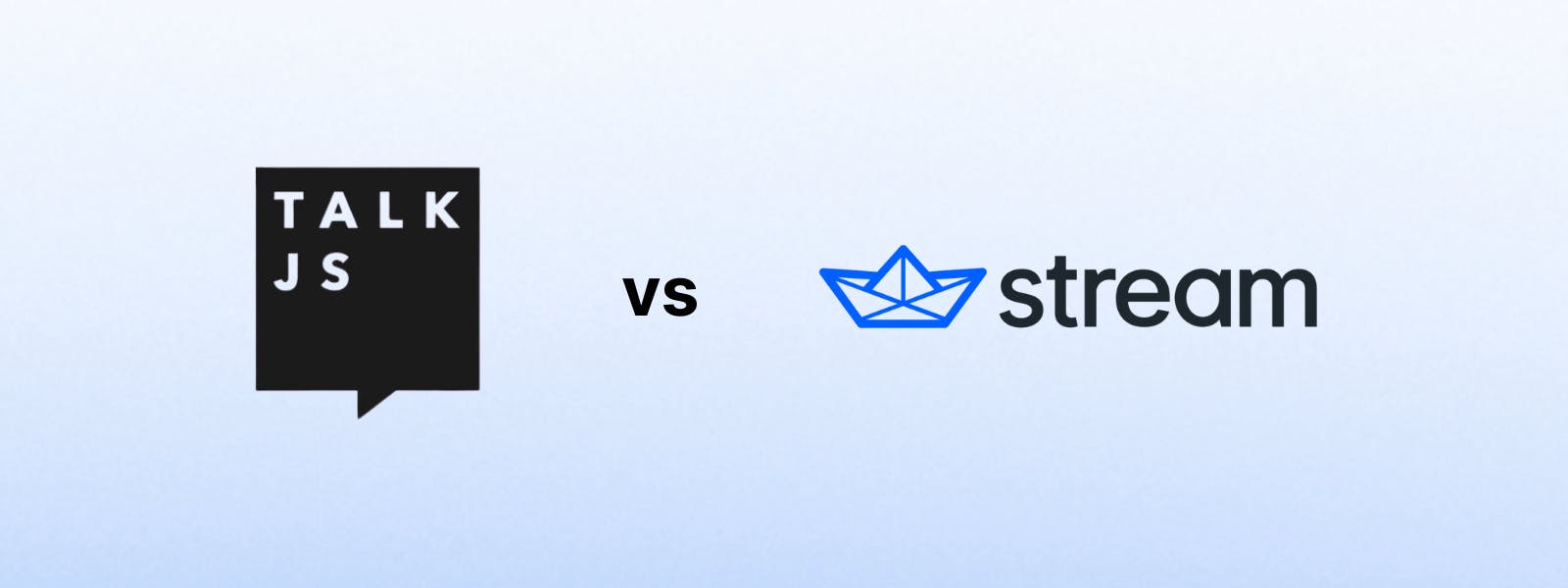
Stream is a developer-focused platform offering APIs and SDKs for chat, voice, video, and AI-powered moderation. Where TalkJS focuses on delivering a ready-to-use, customizable chat UI for fast implementation, Stream provides both polished UI kits and a deep, backend-optimized infrastructure designed to handle high concurrency, low latency, and global scale.
If your team is building a product where messaging is central to the experience, or you plan to expand to other forms of real-time communication, Stream's architectural flexibility and feature set may offer more room for growth than TalkJS's streamlined, UI-first chat approach.
Stream Main Use Cases
-
Social & Community Apps: Power global-scale group chats, rich media sharing, and advanced moderation for user-generated content.
-
Team Collaboration Tools: Combine chat with real-time voice and video for distributed teams, with features like presence indicators, reactions, and thread support.
-
Virtual Events & Livestreams: Host large-scale audience chats, Q&A channels, and backstage communication, with low-latency video and integrated moderation.
-
EdTech Platforms: Enable live class discussions, breakout room chats, and private messaging between students and instructors.
-
Marketplaces: Provide secure buyer-seller communication, with optional voice/video calls to close sales faster.
-
Gaming: Enhance multiplayer coordination with in-game chat, audio rooms, and spectator engagement tools.
-
Telehealth: Facilitate secure, HIPAA-compliant patient-provider communication via text, voice, and video.
-
FinTech Platforms: Support real-time customer support, advisor-client messaging, and secure document sharing with enterprise-grade compliance.
-
Dating Apps: Help users connect through private chat and optional video/audio calls, with built-in moderation for safety.
-
Sports Experiences: Enable live match commentary, fan engagement rooms, and event-specific chat channels for pre- and post-game interaction.
Stream Versus TalkJS
-
Feature Breadth: Stream offers native voice, video, and AI moderation tools, while TalkJS focuses solely on text-based chat (plus voice messages).
-
Customization Options: Both offer theming and UI kits, but Stream's kits are available for more platforms (React, React Native, iOS, Android, Flutter, Unity, and more) compared to TalkJS's smaller SDK set.
-
Scalability: Stream supports unlimited group chat sizes and advanced technologies like SFU cascading for large-scale video calls. TalkJS has participant caps (100 or 300) depending on the plan.
-
Moderation Depth: Stream's moderation covers text, images, and video with AI assistance; TalkJS offers only basic text moderation tools.
-
Compliance: Stream holds SOC 2 Type II, ISO 27001, and HIPAA certifications. TalkJS is GDPR-compliant but lacks these additional certifications, which can be essential in regulated industries.
-
Global Infrastructure: Both Stream and TalkJS operate globally distributed infrastructure to serve users worldwide. The distinction lies in their architectures: Stream's edge network design reduces latency, even running video, and handles high concurrency at scale, while TalkJS focuses on reliable, region-spanning deployments with flexible hosting options.
Stream Pricing
Stream's chat plans are priced by monthly active users, with higher tiers providing access to more advanced features and capabilities.
Chat Pricing:
-
Start: Starts at $399/month for up to 10,000 MAU
-
Elevate: Starts at $599/month for up to 10,000 MAU
-
Enterprise: Talk to Sales
TalkJS vs. CometChat
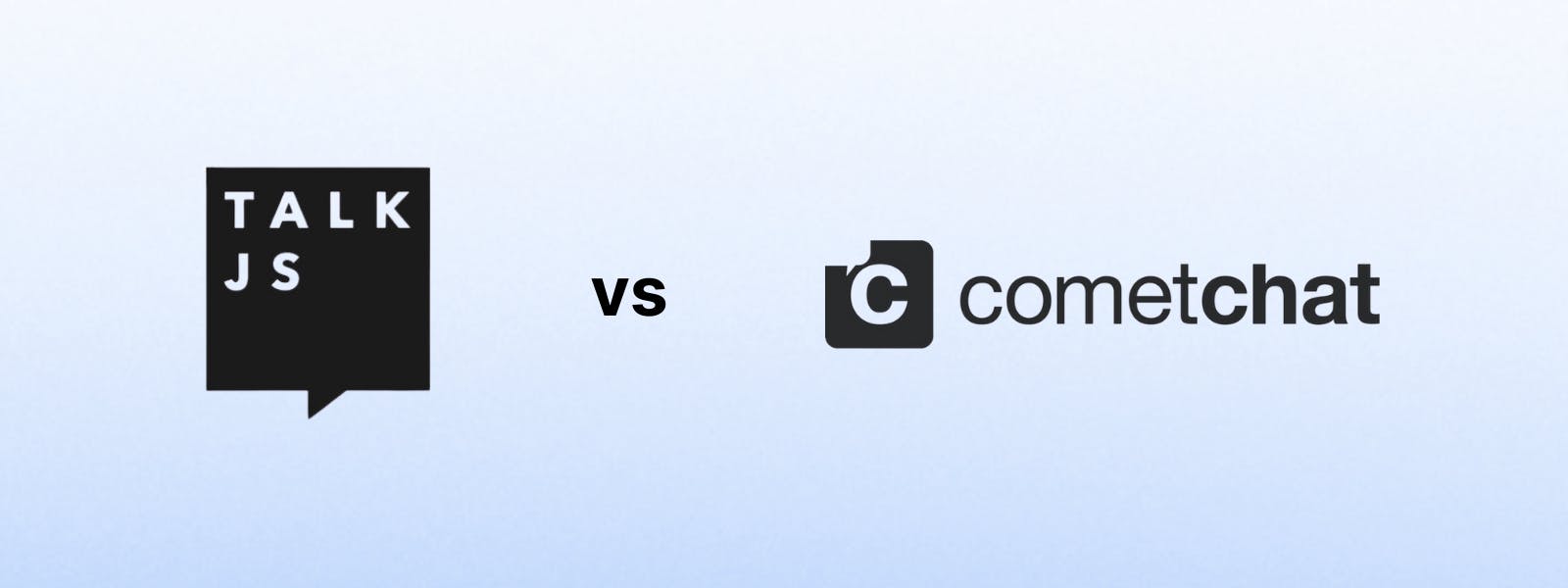
CometChat is a real-time communication platform that offers chat, voice, and video APIs for web and mobile applications. It provides SDKs for 12 platforms, prebuilt UI kits, AI-powered moderation tools, and industry-specific extensions for verticals like dating, telehealth, and education.
CometChat Versus TalkJS
Both CometChat and TalkJS support core messaging features such as 1:1 and group chat, file sharing, read receipts, typing indicators, and user presence. Each also provides a prebuilt UI to accelerate frontend development, as well as GDPR compliance for handling user data.
Where the two differ is in scope and scalability. CometChat supports native voice and video calling, conversation threading, reactions, translation, and AI-driven smart replies—features not available in TalkJS, which is limited to text chat and voice messages. CometChat's SDK coverage is broader, with native support for iOS, Android, Flutter, Unity, and more, while TalkJS offers SDKs for JavaScript, React, React Native, and Flutter only.
On moderation, CometChat includes built-in tools for AI-powered text and image filtering, spam detection, and automated abuse handling. TalkJS moderation is basic, limited primarily to blocking, reporting, and profanity filtering. CometChat also has a public extension marketplace, whereas TalkJS relies on webhooks for integration and does not offer a dedicated marketplace.
In terms of scale, CometChat can handle larger group chats depending on the plan, while TalkJS caps group sizes at 100 participants on its Basic tier and 300 on Growth. Compliance is another differentiator; CometChat supports HIPAA as well as GDPR, making it suitable for healthcare use cases, while TalkJS does not hold HIPAA or SOC 2 certification.
CometChat Chat Pricing
CometChat's pricing scales with the number of features and add-ons:
-
Free: $0/month for up to 100 MAU
-
Basic: Starting at $279/month for up to 10,000 MAU
-
Advanced: Starting at $379/month for up to 10,000 MAU
-
Enterprise: Contact Sales
Custom pricing applies for apps with more than 50,000 MAU, as well as for voice, video, and HIPAA-compliant deployments.
TalkJS vs. Agora
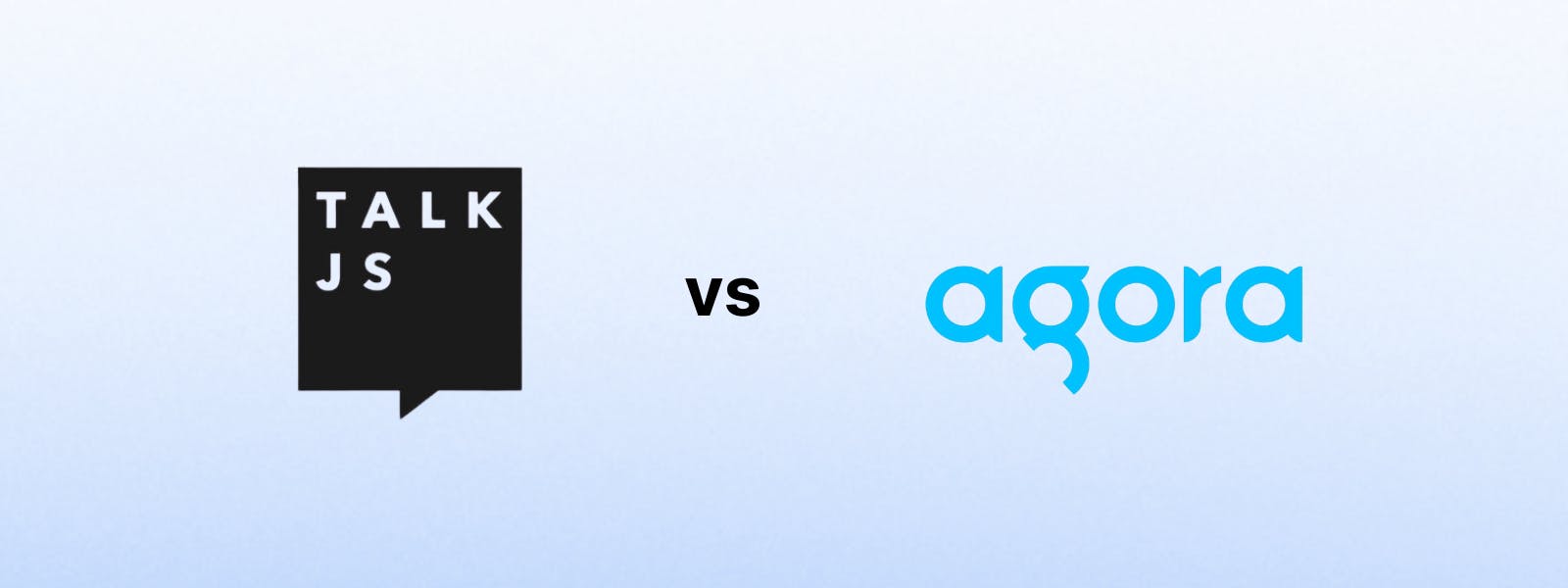
Agora is a real-time engagement platform best known for its voice and video APIs. While its initial focus was on audio and video infrastructure, Agora now also offers a Chat SDK, making it a more complete communication solution for apps that need multiple real-time channels.
Agora Versus TalkJS
Both Agora and TalkJS provide core chat capabilities like 1:1 and group messaging, file sharing, read receipts, user presence, and push notifications. Each also offers prebuilt UI components to help developers integrate faster.
The differences emerge in their strengths. Agora's primary advantage is its infrastructure for high-quality, low-latency voice and video, backed by its SD-RTN™ global network. This makes it especially strong for livestreaming, interactive classrooms, and large-scale media events. TalkJS, by contrast, is focused entirely on text-based messaging with a prebuilt, customizable UI, offering voice messages but no native live calling.
Moderation is another distinction. TalkJS includes basic text moderation tools like profanity filtering, blocking, and reporting. Agora does not include native moderation out of the box; instead, it relies on integrations with third-party tools like Microsoft Azure Content Moderator.
SDK coverage also differs: Agora supports all major platforms, including iOS, Android, React Native, Flutter, Unity, and Windows, whereas TalkJS supports JavaScript, React, React Native, and Flutter only. Compliance-wise, Agora offers HIPAA and GDPR support, while TalkJS is GDPR-compliant but lacks HIPAA certification.
Agora Chat Pricing
Agora's pricing scales with the number of MAUs:
-
Free: $0/month for up to 500 MAU
-
Starter: $349/month for up to 50,000 MAU
-
Pro: $699/month for up to 100,000 MAU
-
Enterprise: Contact Sales
TalkJS vs. PubNub
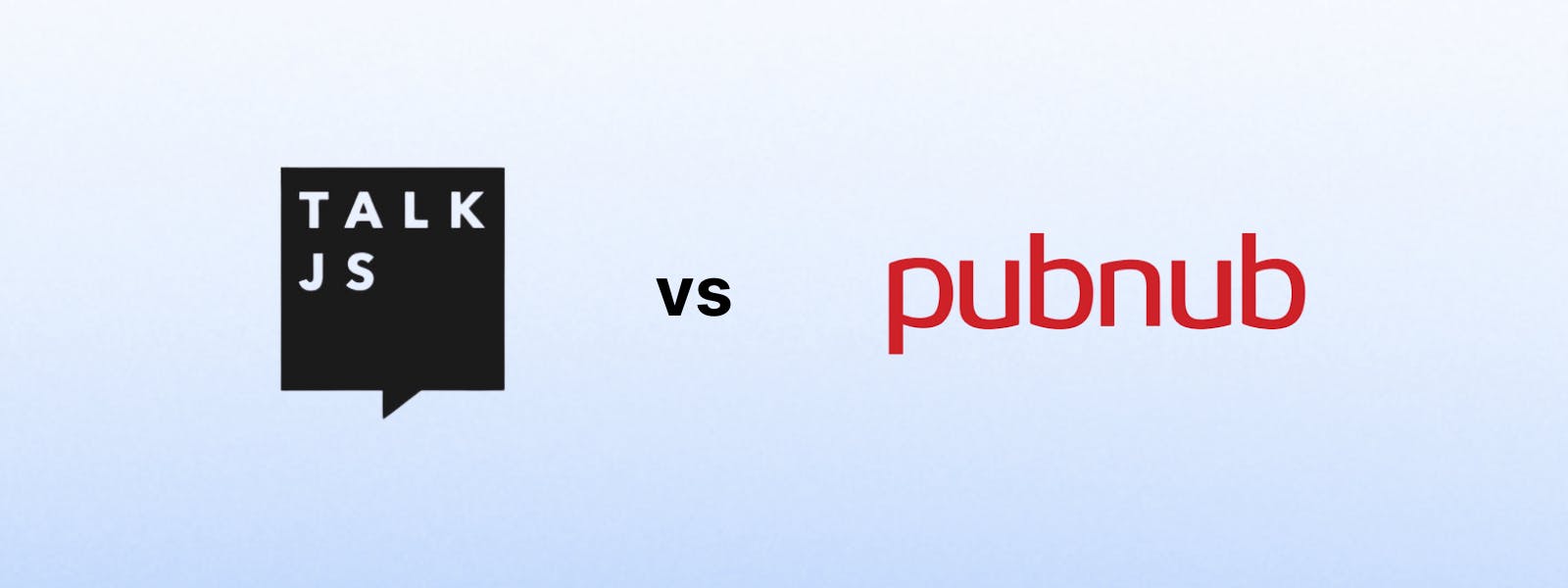
PubNub is a real-time communication platform built on a publish/subscribe architecture. While it's widely used for chat, it also powers use cases like live dashboards, multiplayer games, GPS tracking, and IoT event streaming. Its Chat SDK is designed for teams that want to build highly customized messaging experiences on top of its real-time infrastructure.
PubNub Versus TalkJS
Both PubNub and TalkJS offer 1:1 and group messaging, presence indicators, message storage, and access controls. Each can integrate with backend systems and trigger server-side workflows.
The main difference lies in how they approach the problem. PubNub acts as an infrastructure provider, giving developers low-level APIs to control every aspect of the chat stack. This offers maximum flexibility but requires more build time—especially for the UI, which is not provided out of the box. TalkJS, in contrast, delivers a ready-made, themable chat interface with built-in notifications, significantly reducing time-to-market for teams that don't want to design and maintain their own frontend.
Moderation is another point of divergence. PubNub offers basic tools like access control lists and message filtering, with advanced moderation achievable via integrations. TalkJS includes basic text moderation tools (blocking, reporting, profanity filtering) but lacks image/video moderation and AI-based detection.
Platform coverage is also broader on PubNub's side, with SDKs for numerous web, mobile, and IoT environments. TalkJS supports JavaScript, React, React Native, and Flutter only.
PubNub Chat Pricing
Pricing is based on MAUs and feature access, with higher tiers unlocking capabilities like larger message retention windows and advanced channel management.
-
Free: $0/month for up to 200 MAU
-
Starter: From $98/month for 1,000 MAU
-
Pro: Contact Sales
TalkJS vs. Twilio
Twilio is a cloud communications platform known for its wide range of APIs across SMS, voice, email, and chat. Its Conversations API enables multi-channel messaging, allowing developers to integrate SMS, WhatsApp, and in-app chat into a single experience.
Twilio Versus TalkJS
Both Twilio and TalkJS support core in-app chat features such as 1:1 and group messaging, file sharing, push notifications, read receipts, and typing indicators. Each also provides UI components to help speed up development.
Where the two platforms diverge is in scope and flexibility. Twilio is built for multi-channel communication, letting you combine in-app chat with external channels like SMS or WhatsApp, which makes it well-suited for customer support, field service, and sales engagement workflows. TalkJS, on the other hand, focuses solely on in-app messaging, providing a fully styled and themable UI for web and mobile apps without requiring you to build from scratch.
On moderation, Twilio offers admin controls and supports content moderation via third-party or custom AI tools, while TalkJS provides basic built-in tools like blocking, reporting, and profanity filtering.
In terms of SDK coverage, Twilio supports seven platforms, including iOS, Android, and JavaScript, compared to TalkJS's four. Compliance-wise, Twilio meets SOC 2 and HIPAA requirements; TalkJS is GDPR-compliant but does not offer HIPAA or SOC 2 certification.
Twilio Chat Pricing
Twilio's Conversations API doesn't offer subscriptions. It's a pay-for-what-you-use model with per‑user pricing.
-
Usage: $0.05 per active user per month
-
Media Storage: $0.25 per GB per month
TalkJS vs. Ably
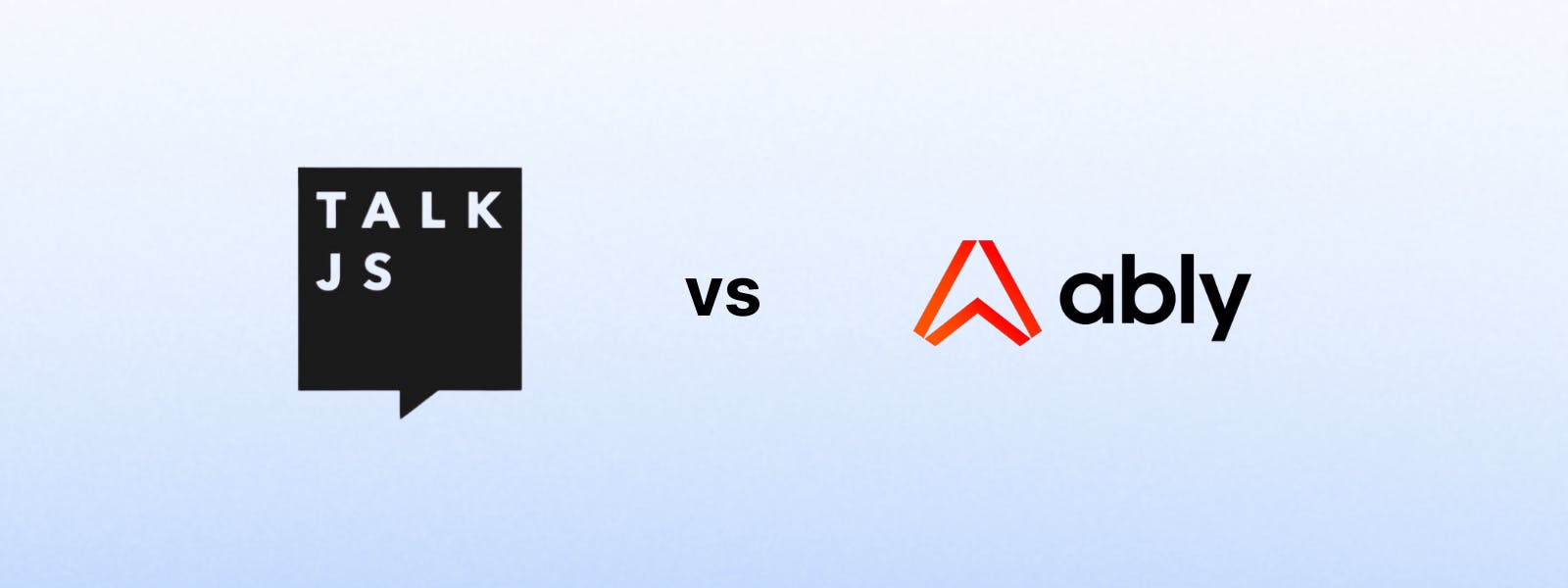
Ably is a real-time infrastructure platform designed for delivering low-latency messaging at scale. While it's not a chat-first provider, its pub/sub architecture can be used to power custom chat applications alongside other real-time use cases like live dashboards, multiplayer games, GPS tracking, and IoT event streaming.
Ably Versus TalkJS
Both Ably and TalkJS enable real-time, in-app communication. Ably provides the infrastructure for message delivery, presence, message history, and access control, while TalkJS delivers a prebuilt chat interface with integrated notifications and basic moderation tools.
The key difference is in their development approach. Ably gives you low-level building blocks to architect a completely custom chat experience, which offers maximum flexibility but requires significant frontend and backend work—especially for the UI, which it does not provide. TalkJS takes the opposite route, supplying a fully styled and themable chat UI so teams can launch messaging quickly without deep infrastructure expertise.
Moderation is another point of contrast. Ably does not include native moderation tools, instead relying on developers to build their own or integrate third-party services. TalkJS offers built-in text moderation features like profanity filtering, blocking, and reporting, but no AI-based or image/video moderation.
In terms of platform coverage, Ably supports a wide range of SDKs across web, mobile, and IoT. TalkJS supports JavaScript, React, React Native, and Flutter only. Compliance-wise, Ably is SOC 2 Type II and GDPR-compliant, while TalkJS is GDPR-compliant but does not have SOC 2 certification.
Ably Chat Pricing
Ably uses a usage-based pricing model that applies to chat workloads as well:
-
Free: $0/month for up to 200 concurrent connections
-
Standard: $29/month + consumption-based charges for up to 10,000 concurrent connections
-
Pro: $399/month + consumption-based charges for up to 50,000 concurrent connections
-
Enterprise: Contact Sales
TalkJS vs. Vonage
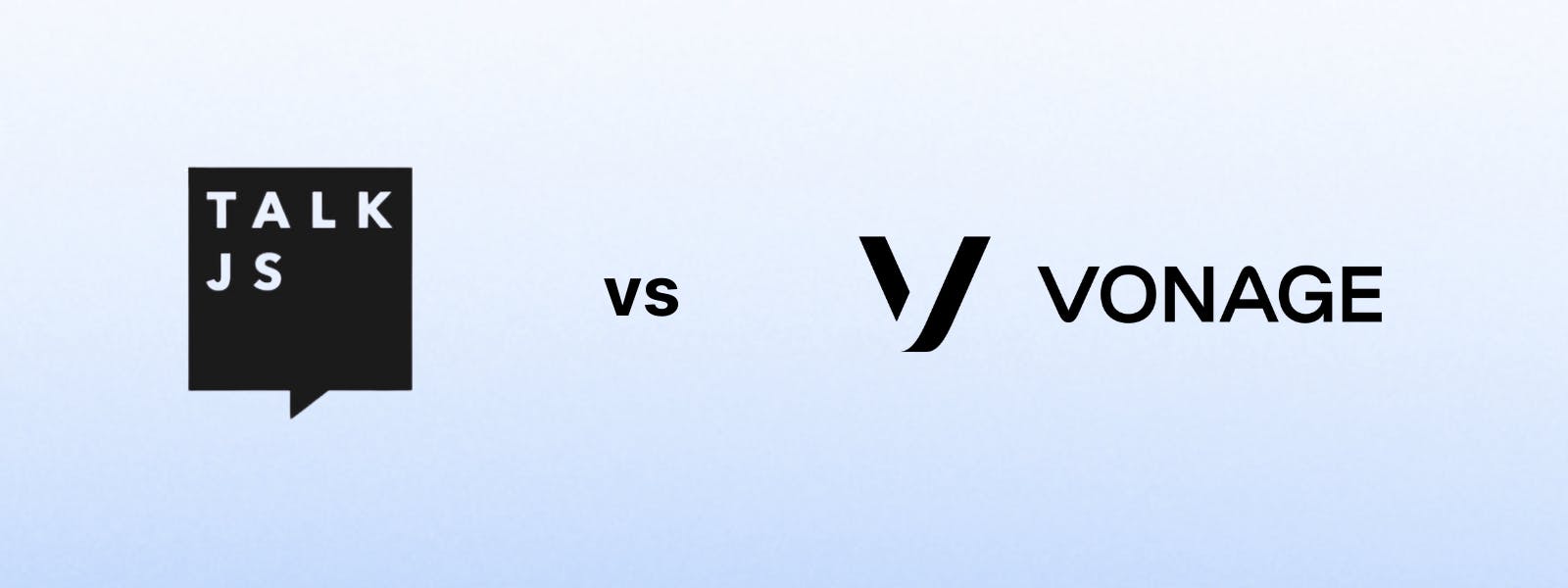
Vonage is a cloud communications provider offering APIs for messaging, voice, video, and SMS. Its Conversations API supports multi-channel communication, allowing developers to build in-app chat experiences alongside external messaging channels like WhatsApp, Facebook Messenger, and SMS.
Vonage Versus TalkJS
Both Vonage and TalkJS offer 1:1 and group chat, file sharing, user presence, and message history. Each provides UI components to speed up frontend implementation and supports GDPR compliance for data handling.
They differ in scope and deployment options. Vonage's strength lies in its omnichannel approach, letting you unify in-app messaging with external communication channels for a more connected customer experience. This makes it well-suited for customer engagement, telehealth, and service coordination. TalkJS focuses entirely on in-app messaging, with a fully prebuilt, themable UI and built-in notifications, making it faster to launch but narrower in communication scope.
On moderation, Vonage offers admin tools and supports content filtering via AI integrations, while TalkJS includes basic tools for text moderation, blocking, and reporting. In terms of SDK coverage, Vonage provides client SDKs for web, iOS, and Android, compared to TalkJS's JavaScript, React, React Native, and Flutter. Vonage also holds HIPAA and SOC 2 compliance, while TalkJS is GDPR-compliant only.
Vonage Pricing
Vonage offers usage-based pricing for its Conversations API:
- Starting at $0.0008 per custom event post
Alternatives Comparison Chart
| Provider | Chat SDKs | Voice & Video | Built-in Moderation | UI Kits | Global Edge Network | HIPAA Compliance | SFU Cascading |
|---|---|---|---|---|---|---|---|
| TalkJS | ✅ (JavaScript, React, React Native, Flutter) | ❌ (Voice messages only) | ✅ (Basic text) | ✅ (Prebuilt, themable) | ✅ (90+ regions) | ❌ | ❌ |
| Stream | ✅ | ✅ | ✅ (AI text, image, video) | ✅ | ✅ | ✅ | ✅ |
| CometChat | ✅ | ✅ | ✅ (AI text, image) | ✅ | ✅ | ✅ | ❌ |
| Agora | ✅ | ✅ (Core strength) | ✅ (Via partner integrations) | ✅ | ✅ (SD-RTN™) | ✅ | ✅ |
| PubNub | ✅ | ✅ (Partial – signaling only) | ✅ (Basic; advanced via integrations) | ❌ | ✅ | ✅ | ❌ |
| Twilio | ✅ (Conversations API) | ✅ | ✅ (Admin + AI/custom) | ✅ | ✅ | ✅ | ❌ |
| Ably | ✅ (Infra-focused) | ❌ | ❌ (Build your own / integrate) | ❌ | ✅ | ✅ | ❌ |
| Vonage | ✅ | ✅ (Core strength) | ✅ (Admin + AI via integration) | ✅ | ✅ | ✅ | ❌ |
Choosing Between TalkJS and the Competition
The TalkJS alternatives we've covered range from lightweight messaging layers (like PubNub or Ably) to full-featured communication suites (like Stream or CometChat). Some (such as Stream, Agora, or Vonage) are best if you need voice and video alongside chat. Others, like TalkJS itself, shine when you want to drop in a ready-made UI and start chatting in minutes.
Your best choice comes down to your product roadmap, technical resources, and compliance needs. If speed of implementation and minimal backend work are your top priorities, TalkJS delivers. But if your long-term vision involves advanced moderation, cross-platform SDK coverage, or adding real-time media, it may be worth starting with a platform that offers those capabilities out of the box.
Many competitors offer free trials or developer tiers, making it easy to build a quick proof of concept before committing. That's often the fastest way to confirm whether a provider's features and pricing fit your needs now—and in the future.

